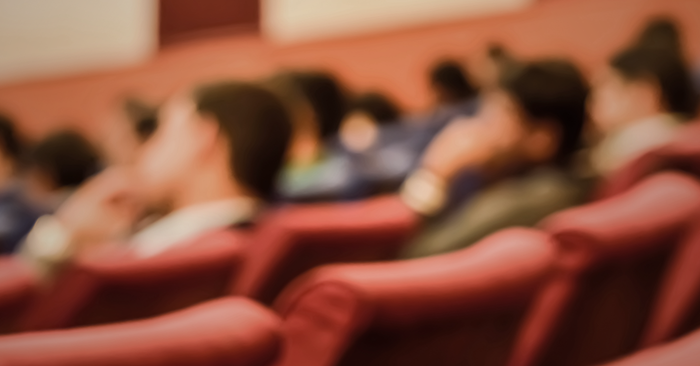
Have you ever wished that more of your teaching colleagues would attend your concerts? Wouldn’t it be nice if they could hear and see what your students are capable of? How might you get more of your community involved in your program? Would you welcome having more than just the parents of your students in your concert audience?
These are just some of the questions that I have asked myself over the course of 33 years of directing bands and choirs at multiple levels. While some answers remain elusive, I’m glad to share a few of the ideas I’ve come up with for increasing faculty and community involvement.
Fellow Educators
Getting your faculty colleagues to attend school concerts can be difficult. They are all as busy as you are with planning, grading, and a multitude of other responsibilities. Nevertheless, there are ways to increase the likelihood of their participation.
A quick search of jwpepper.com led me to several “novelty” tunes that offer ways to include faculty members in your concert performance. These include (but are not limited to) James Ployhar’s Concerto for Faculty and Band and Second Concerto for Faculty/Band.
You might discover that a piece like this could become the perfect way to have the head football coach “play” along with the band.
Imagine the laughs you’ll get when it all goes wrong and you have to “politely” remind the coach about counting or rhythm. If you’re a band director, and have had to lead the pep band at football games, this could present you with the ideal opportunity for some good-natured “payback.” Of course the coach, his family, and other members of the faculty will not want to miss this.
Community Narrators
You might also search for pieces that include narrator parts; there are many very good examples available. Jim Curnow’s Heritage of Freedom is one such piece that calls for a strong narrator as the music progresses. Imagine having a local radio personality, doctor, or your mayor perform the narrator role. Even if none of these people have ever attended one of your concerts before, they may be willing to participate – simply because you asked. And of course, when they take the stage their friends, family, and colleagues will want to be in the audience.
Community Musicians
Similarly, there are likely many singers and instrumentalists in your community who have yet to attend one of your concerts. By inviting them to perform with the group, you may be opening a door to a potential music program supporter.
Perhaps you know of a vocalist in your community who would love an opportunity to perform Somewhere over the Rainbow, but has never been approached or invited to do so. You take a risk that the soloist may not bring the musicianship you would like, but you stand to broaden your audience and expand your connection with your community. Available pieces for guest soloists range from very easy to very difficult. It’s up to you to find the right arrangement – and level of difficulty – for this opportunity. Nevertheless, I believe the benefits you could enjoy have the potential to be far-reaching.
Taking it Further
I’d like to close by sharing an example of how it’s possible to take community involvement to the next level.
One year I decided that the theme of our fall concert would be “Dances from Around the World.” While playing in a local pit orchestra I learned that the director was not only an accomplished musician but had also competed as an Irish dancer in a statewide talent contest. I approached her, asked if she would choreograph a dance to Leroy Anderson’s Irish Washerwoman, and she kindly agreed.
Her dance performance at our concert was literally show-stopping. The audience response was overwhelming.
Also on the program was the Offenbach’s Schuller Polka. I had heard that a young woman on our campus was currently serving as Miss Czech Slovak of Iowa. What’s more, she was reputed to be a terrific dancer. She also agreed to participate.
At the concert she performed an incredible dance in a traditional Czech dress. The polka, further enhanced by a strong lead clarinet, produced another memorable moment in a truly great concert.
Obstacles
As directors, we are sometimes our own worst enemies. We often take ourselves too seriously and forget that there are many resources available outside of our own rooms. Engaging a faculty member or community leader to participate builds relationships that can provide tremendous rewards. Because of opportunities like these, I have become wonderful friends with people outside of the band room who have gone on to sing the praises of our music program.
Even if it doesn’t become a regular (or annual) practice for your program, offering an occasional “special” guest performance can be an added draw and a highlight. Filling the seats at your concerts is rewarding for yourself, your students, your school, and the community. Why not give it a try?
Glenn Pohland , D.M.A., is the director of instrumental music at Loras College and an assistant professor in the communication and fine arts division. He conducts the wind ensemble, jazz ensemble and chamber groups; serves as instructor of the low brass studio; and teaches courses in music education, orchestration, music history, instrumental techniques and conducting.
, D.M.A., is the director of instrumental music at Loras College and an assistant professor in the communication and fine arts division. He conducts the wind ensemble, jazz ensemble and chamber groups; serves as instructor of the low brass studio; and teaches courses in music education, orchestration, music history, instrumental techniques and conducting.
Previously, Dr. Pohland was an assistant professor of instrumental music education at the University of Minnesota in Minneapolis. He served for 24 years as the director of bands and general music teacher in the Glencoe-Silver Lake, Minnesota, school district. He is also an active adjudicator, clinician and guest conductor.